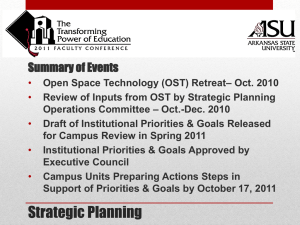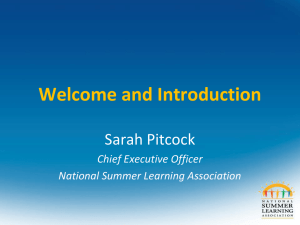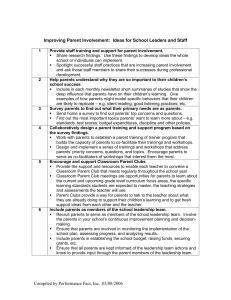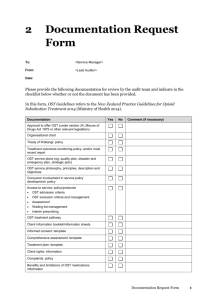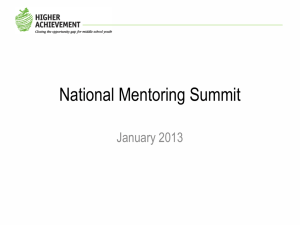Defining Our Terms: Professional Development in Out-of
advertisement
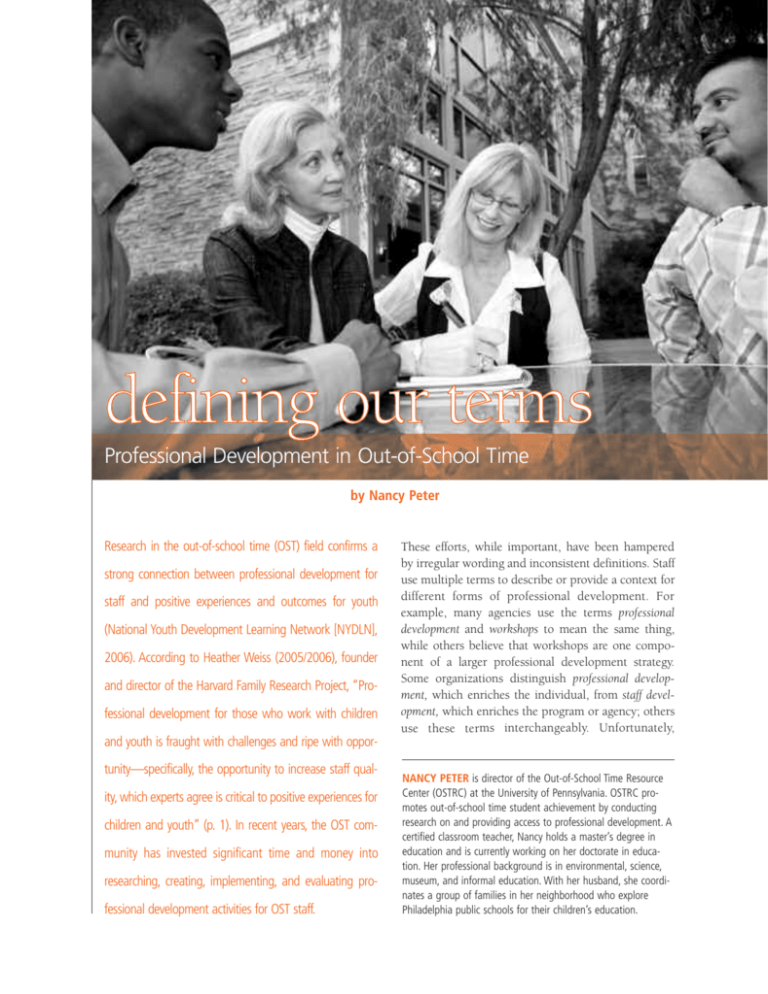
defining our terms Professional Development in Out-of-School Time by Nancy Peter Research in the out-of-school time (OST) field confirms a strong connection between professional development for staff and positive experiences and outcomes for youth (National Youth Development Learning Network [NYDLN], 2006). According to Heather Weiss (2005/2006), founder and director of the Harvard Family Research Project, “Professional development for those who work with children These efforts, while important, have been hampered by irregular wording and inconsistent definitions. Staff use multiple terms to describe or provide a context for different forms of professional development. For example, many agencies use the terms professional development and workshops to mean the same thing, while others believe that workshops are one component of a larger professional development strategy. Some organizations distinguish professional development, which enriches the individual, from staff development, which enriches the program or agency; others use these terms interchangeably. Unfortunately, and youth is fraught with challenges and ripe with opportunity—specifically, the opportunity to increase staff quality, which experts agree is critical to positive experiences for children and youth” (p. 1). In recent years, the OST community has invested significant time and money into researching, creating, implementing, and evaluating professional development activities for OST staff. NANCY PETER is director of the Out-of-School Time Resource Center (OSTRC) at the University of Pennsylvania. OSTRC promotes out-of-school time student achievement by conducting research on and providing access to professional development. A certified classroom teacher, Nancy holds a master’s degree in education and is currently working on her doctorate in education. Her professional background is in environmental, science, museum, and informal education. With her husband, she coordinates a group of families in her neighborhood who explore Philadelphia public schools for their children’s education. ary at the beginning of a seminar on intermediaries, discussing multiple interpretations of safety when developing a vision statement that addresses community safety, and more. Since professional development terms and Why Definitions Matter interpretations are inherently diverse, introductory defiWhy is it problematic that one organization’s training series nitions should include contextual disclaimers such as “For the purpose of this workshop…” or “According to is another’s professional development strategy? What is the our organization….” harm in using the terms capacity building and quality improvement interchangeably? In a relatively new field A second, more substantive and challenging such as OST, shouldn’t we expect a great deal of variation approach would be to agree on a set of common proin our definitions and terminology? fessional development terms and It is precisely because OST is a definitions. This will not be easy, as I have been in meetings the field struggles with muddled terrapidly evolving field that we with grant makers and should pay closer attention to our minology in many settings. For terms and communication. OST example, national surveys document government staff who draws from multiple disciplines extreme diversity in job titles that expressed confusion— including classroom education, share similar job responsibilities, and frustration—over social work, daycare, and recreeven within the same city (Buherthe variety of overlapping ation, each with its own nomenclaKane & Peter, 2008; LeMenestrel & ture. To communicate effectively Dennehy, 2003). In one Philadelphia terms emanating from among ourselves, we need to know setting, a youth worker is an adult our field. who works with youth; in another, it that various professional developis a young person who works. Such ment terms mean the same thing to diversity hinders efforts to establish credentials and various individuals or organizations. For example, my career ladders in our emerging field. We have to continorganization, the Out-of-School Time Resource Center ually remind ourselves of where we are and with whom (OSTRC), was recently asked to evaluate a technical assistance strategy. Since our expertise is in evaluating workwe are conversing. shops and conferences, we developed new instruments Yet the OST field is making linguistic progress. We to monitor what we assumed would be less formal, more have developed many sanctioned sets of national proindividualized interventions—only to learn that the gram standards (Breslin, 2003), have identified multiple “technical assistance” we would be evaluating consisted youth worker competencies (NYDLN, 2003), and are of a series of trainings. working on a series of afterschool trainer guidelines Similarly, the OST field is working hard to estab(National Afterschool Association, 2008). lish our legitimacy with funders, legislatures, and the To jumpstart a conversation about OST professional public (Afterschool Alliance, 2005). Being consistent in development terminology, the following section presents our terminology and message strengthens our collective a set of commonly used terms. For each, I begin by gathcredibility. I have been in meetings with grant makers ering definitions from other fields and then provide and government staff who expressed confusion—and examples of how the OST community has adapted and frustration—over the variety of overlapping terms emarefined these terms. Finally, I propose a series of OST nating from our field. Anything we can do to lessen the professional development definitions. These are my own interpretive burden on others, particularly stakeholders, definitions, based on research in multiple fields; I intend benefits everyone. them to serve as conversation starters, not proclamations. One immediate way to promote effective communication is to preface all OST professional development Professional Development Definitions conversations by introducing and defining our terms. For With the exception of the first phrase, professional develexample, when conducting OST workshops, the OSTRC opment, I present all definitions below in alphabetical introduces a working definition of professional developorder, not in order of importance. The terms I have choment so that all participants are speaking the same lansen are derived from but do not represent a complete guage. We have also found this strategy helpful in other spectrum of professional development formats, proOST situations: brainstorming about the term intermedigrams, and opportunities. I have included the terms because there is no standard OST professional development glossary, we have no common reference point through which to synchronize our terminology. Peter DEFINING OUR TERMS 35 capacity building and quality improvement, even though they do not relate exclusively to professional development, because they are often used in describing professional development strategies. Professional Development Definitions from related fields. Professional development is defined differently in different fields. In the business world, professional development is designed to help organizations enhance workforce effectiveness and productivity (Broad & Newstrom, 1992). The National Staff Development Council defines professional development for classroom teachers as “a comprehensive, substantiated and intensive approach to improving teachers’ and principals’ effectiveness in raising student achievement” (Mizell, 2008). According to the U.S. Department of Education (1998), teacher professional development should respect the leadership capacity of teachers, emphasize individual and organizational improvement, integrate current research in teaching and learning, provide content and strategies, promote continuous inquiry, and be evaluated on the basis of teacher and student impact. Across fields, professional development activities can include workshops, conferences, study groups, professional networks, task forces, and peer coaching (Porter, Garet, Desimone, & Birman, 2003) as well as program observations, journaling, curriculum development, and higher education (NSDC, 2004). OST context. Weiss (2005/2006) defines professional development as “a full range of activities that have the common goal of increasing the knowledge and skills of staff members and volunteers” (p. 1). Boston’s BEST Initiative, which offers youth development trainings and institutes, adds that “professional development refers to tools and activities that improve professional performance and the efficiency of a project, program, organization, or institution” (Youth Work Central, 1999). Professional development formats and settings include higher education activities; pre-service and in-service training; seminars and resource centers; credentialing systems and programs; local and national conferences; mentoring and coaching relationships; and informal resources such as newsletters, online discussion boards, and “brown bag” lunches (Bouffard & Little, 2004). Overall, OST professional development strives to enhance the individual, the program, and the field simultaneously. Proposed definition. Professional development refers to a spectrum of activities, resources, and supports that 36 Afterschool Matters help practitioners work more effectively with or on behalf of children and youth. Professional development formats include workshops, conferences, technical assistance, apprenticeships, peer mentoring, professional memberships, college coursework, and additional diverse offerings. Practitioners can be full-time staff, part-time staff, volunteers, teenagers, parents, or other non-staff members, provided that the professional development experience culminates in supporting OST youth participants. Because youth impact is always the ultimate goal, staff development is indistinguishable from professional development. Capacity Building Definitions from related fields. In her book Investing in Capacity Building, Blumenthal (2003) broadly defines capacity building as actions that improve nonprofit effectiveness. Capacity building in nonprofit agencies is comparable to organizational development, organizational effectiveness, and organizational performance management in for-profit organizations (McNamara, 1997). Capacity-building strategies involve human resource development, such as staff training, as well as organizational, structural, and administrative enhancement (Global Development Research Center, 1992). OST context. Capacity building of programs and networks often refers to increasing both their depth, or quality, and their breadth in terms of number of sites, participants, contact hours, and activities. Specific capacitybuilding outcomes include increased numbers of highimpact programs, qualified staff, sound administrative processes, and sustainability strategies (American Youth Policy Forum, 2008). High-level organizational activities associated with achieving these outcomes are articulating a core vision, assigning coordination to a non-government entity, creating an advisory body of influential members, identifying dedicated funding for infrastructure development, adhering loosely rather than rigidly to the initial plan, and expanding gradually rather than rapidly (Robert Wood Johnson Foundation, 2008). Proposed definition. On a systemic and organizational level, capacity building refers to increasing both the quality of programs and the scope of services. In the context of professional development, capacity building is indistinguishable from effective professional development: Both strive to enhance the knowledge, skills, and confidence of staff, and, in turn, the positive impact on programs and participants. Fall 2009 Mentoring, Coaching Definitions from related fields. The terms mentoring and coaching are frequently used interchangeably in the education community. Both describe enriching relationships between professionals (NYDLN, 2004). However, a distinction can be made. Mentoring can be defined as an ongoing relationship between a supportive and knowledgeable guide and a less experienced learner (Omatsu, 2004). In contrast, coaching often occurs between peers, pertains to solving specific problems, and takes place on an as-needed basis (Association for Supervision and Curriculum Development, 2008). Mentoring is frequently associated with enriching the individual, while coaching generally focuses on enhancing a program (Center for Coaching and Mentoring, 2008). Lastly, mentoring relationships often develop and are maintained between individuals from different organizations, while coaching arrangements are usually site-based and site-specific. OST context. Mentoring and coaching share many basic characteristics. According to Minnesota SMART, both involve individual relationships in work or education settings through which one person shares knowledge, skills, assistance, and/or support with another. Mentoring and coaching can be brief or continuous, address specific issues or general concerns, work in hierarchical or peer relationships, and be equally beneficial to both participants (Minnesota SMART, 2007). One difference is that mentors often follow individuals from position to position, whereas coaches generally concentrate on job-specific issues. An additional distinction is that mentors frequently offer a broad knowledge base, while coaches share expertise on a single or limited number of topics. Proposed definition. In many circumstances, the terms mentoring and coaching are interchangeable. Both are used to describe professional relationships that enrich Peter individuals as well as programs. Mentoring and coaching can be short-term or long-term, address specific issues or general concerns, take place within hierarchical or peer relationships, and involve staff from the same organization or different organizations. Effective mentoring and coaching typically benefit both participants equally. Peer Networking Meetings, Professional Learning Communities Definitions from related fields. Peer networking meetings and professional learning communities are forums in which groups of practitioners assist one another in their professional growth and competence. Prevalent among classroom teachers and administrators, professional learning communities can include individuals from one or more programs or agencies, involve scheduled meetings or informal gettogethers, address specific topics or multiple interests, and involve virtual Internet communication as well as face-to-face relationships (Murphy, 1997). Leiberman (1996) suggests that peer networking and professional learning communities provide opportunities for teachers to develop and reflect on their work and discuss their ideas, gain expertise not available in their schools, participate in a culture of ongoing inquiry, observe other professionals involved in intensive self-renewal and school change, and expand their understanding of policy and practice. OST context. The After-School Institute (2008) defines its monthly peer networking meetings as “a forum to discuss, evaluate, plan, update, and conduct resource sharing, which serves as the primary catalyst for all other [professional development] activities.” The OSTRC hosts monthly peer networking meetings that provide opportunities for staff to share resources and develop new professional relationships; participants use these experiences to enhance their programs and thus improve student outcomes. Peer networking meetings DEFINING OUR TERMS 37 (PNMs) can target staff from one organization or many, address direct-service and/or administrative staff, and be voluntary or mandatory. They may provide credits toward state- or city-mandated training. PNMs differ from formal workshops in that they do not use lecture as a primary activity; they do include ample opportunities for staff networking and feature peers, rather than external authorities, as panelists or presenters. tures, such as adult-youth relationships (Little, 2007). Quality improvement strategies include professional development activities such as workshops, technical assistance, and coaching. They may also involve other types of interventions, including direct funding, volunteer recruitment, and facility improvements (Granger, 2007). Continuous quality improvement systems help agencies monitor and enhance As it relates to their own programs over extended professional development, periods of time (Weisburd & quality improvement McLaughlin, 2004). Proposed definition. Peer networking meetings are venues in which staff are encouraged to meet and refers to programmatic get to know one another; share Proposed definition. Quality improveimprovements that are interests, expertise, and resources; ment, in its broadest sense, includes the direct result of and engage in collective problem all interventions that enhance the effective professional solving. Unlike traditional worksuccess of a program. These intershops or trainings, PNMs use diaventions may include staff training, development. logue as the primary activity, physical upgrades, and financial support. As it relates to professional include ample time for networking, development, quality improvement refers to programand feature peers rather than experts as panelists or prematic improvements that are the direct result of effective senters. PNMs can involve staff from one organization professional development. or many. Participants may have comparable or diverse job responsibilities, come from similar or dissimilar Technical Assistance programs, and represent specific or broad geographic Definitions from related fields. Minnesota SMART areas. As with all professional development activities, (2007) defines technical assistance (TA) as a relationship PNMs strive to enrich staff as a means of enhancing probetween an expert and a client in which the expert programs and participants. vides the client with customized assistance regarding a Quality Improvement specific programmatic issue. TA can help staff define Definitions from related fields. In the nonprofit sector, problems, analyze problems, and develop practical and the term quality improvement refers to many things: effective responses (Bureau of Justice Assistance, 2007). enhancing the customer or client experience, enriching While agencies often combine the terms training and technical assistance into a single heading or service, trainorganizational or programmatic infrastructure, cultivating ings are usually more formal and generalized while techstaff growth and competence, and increasing the inherent nical assistance is less structured and more value of services and resources. All quality improvement situation-specific. efforts require leaders to assess, organize, and encourage improvement, building on a foundation of staff trust. Strategies must begin with administrative and staff supOST context. Technical assistance is broadly defined and port, be broken down into manageable components, and often used interchangeably with the terms consultation (National Institute on Out-of-School Time, 2008), cusbe introduced in a climate in which people willing and tomization (Center for Afterschool Education, 2008), able to implement change (Berman, 1998) . intensive institution-specific assistance (The After-School OST context. Quality improvement means maximizing Institute, 2008), agency mentoring (Partnership for After the number of promising practices in an OST program School Education, 2008),and service-on-demand or agency (Rand Corporation, 2005). Promising prac(National Center for Quality Afterschool at the Southtices are those that have been tangibly linked to an west Educational Developmental Laboratory, 2008). increased likelihood of student achievement (Peter, Fletcher (2004) describes OST technical assistance as 2002). Such practices can be divided into structural fea“ensuring accountability, guaranteeing compliance with tures, such as program administration, and process fearequirements, and supporting programs in specific ways 38 Afterschool Matters Fall 2009 by answering questions and providing information and advice” (p. 16). In the OST field, TA differs from trainings and workshops in that it frequently takes place at the program site; often involves staff from single rather than multiple organizations; may be less formal and more conversational than a training session; focuses on an issue or issues of specific interest to the staff, program, or agency; may be initiated by the client (insider) or the expert (outsider); and may extend beyond a predetermined duration. Proposed definition. Technical assistance refers to customized help and support that addresses specific issues or needs. External experts may provide TA to individual staff members, multiple staff members, entire programs, or entire organizations. While TA is often implemented on-site with individuals from a single organization, it can also be offered off-site for representatives from multiple programs or agencies. TA can be initiated by recipients, program monitors, administrative personnel, or funding agencies. Workshops, Trainings Definitions from related fields. The terms workshops and trainings are often used interchangeably. According to Merriam-Webster (2008), a workshop is usually a brief educational program for a small group of people that focuses on techniques and skills in a particular field. Broad and Newstrom (1992) define trainings as “instructional experiences provided primarily by employers for employees, designed to develop new skills and knowledge that are expected to be applied immediately upon arrival or return to the job” (p. 5). In general, workshops are expected to yield long-term benefits while trainings address specific situations and skill-sets. Workshops can also be a component of a training strategy, while trainings are rarely embedded in workshops. OST context. Many organizations use the term training to describe a broad range of professional development activities. Workshops are more likely to present general knowledge—for instance, “Introduction to Youth Development”—while trainings generally offer skill development in areas such as CPR, grant-writing, or implementing a specific curriculum. However, most organizations use the two terms to mean essentially the same thing: formal venues in which OST staff learn to work with rich curriculum, forge supportive relationships with youth, and partner with communities to achieve optimal results (The After School Corporation, Peter 2008). Workshops and trainings generally last from one to three hours, are implemented by one or more facilitators, can be held on-site or off-site, can accommodate staff from one or more programs, can be single-session or multi-session, can be offered alone or as part of a larger conference or symposium, and can cover a wide range of content and skills (Partnership for After School Education, 1999). Proposed definition. Generally speaking, workshop and training are synonymous terms that describe formal sessions in which staff learn content and skills that are immediately useful or broadly applicable. Workshops and trainings can be facilitated by one or more presenters, held on-site or off-site, include staff from one or more programs, be single-session or multi-session, and cover a broad range of topics. The overarching goal of workshops and trainings is to improve program quality through staff development. Toward Consistent Terminology As with many evolving fields, the out-of-school-time profession struggles with terminology and consistency. Although many agree that professional development is a critical element of program quality and student impact, few concur on its precise definitions or components. By exploring and defining seven OST professional development terms, I hope to ignite a conversation about professional language, consistent terminology, and productive communication. This conversation can only enrich the field as it continues to design and implement professional development activities, collect information on effective interventions, and convey its resources and findings to other professions. I have proposed broad and inclusive definitions rather than specific and exclusive ones. Similarly, I have combined terms, such as workshops and trainings, when the distinctions between the two are inexact, fluid, or debated. I included the terms capacity building and quality improvement because they are frequently used to describe professional development activities or outcomes. However, since these terms pertain more to programs and systems than to professional development, I would not generally include them in a conversation specifically about professional development. This article has not covered many additional professional development formats that are less familiar but equally creative and effective. These venues include administrative and frontline observations and apprenticeships, university coursework and degrees, multi-year DEFINING OUR TERMS 39 career lattices, youth worker certification programs, and OST professional development standards (NYDLN, 2006). While vastly different in format and delivery, all types of OST professional development should be designed for and culminate in enhancing student outcomes and achievement. Thus, it is misleading to distinguish professional development that influences the individual from that which affects programs or program participants, particularly in this field where staff frequently change positions and move from one organization to another. Regardless of how it is initiated or implemented, quality professional development should enrich the staff person as a means toward enriching the students. The terms defined in this paper are clearly complex and open to interpretation. In an immediate effort to enhance communication, organizations should use professional development terms consistently in their literature and outreach materials, defining those terms whenever possible. The ultimate goal of this paper is to begin a conversation in which a national collaborative of OST organizations can agree on a common set of professional development definitions. Acknowledgements Bouffard, S., & Little, P. (2004). Promoting quality through professional development: A framework for evaluation. Harvard Family Research Project. Issues and Opportunities in Out-of-School Time Evaluation, 8. Breslin, T. (2003). Out-of-school time program standards: A literature review. Providence: Rhode Island KIDS Count. Broad, M. L., & Newstrom, J. W. (1992). Transfer of training: Action-packed strategies to ensure high payoff from training investments. Reading, MA: Addison-Wesley. Buher-Kane, J., & Peter, N. (2008). A new system of classifying out-of-school time job responsibilities. Unpublished manuscript. Bureau of Justice Assistance. (2007). Training and technical assistance strategy. Washington, DC: U.S. Department of Justice. Center for Afterschool Education. (2008). Core trainings. Retrieved October 28, 2008, from http://www.caceafterschool.org/training_events/ what_we_offer.php#ta Center for Coaching and Mentoring. (2008). Coach, mentor: Is there a difference? Retrieved on November 4, 2008, from http://www.coachingandmentoring.com/ Articles/mentoring.html The author acknowledges the following staff of the Outof-School Time Resource Center for their contributions to this article: Lisa Colby, MSW, LSW, senior research coordinator; Katie Derickson, communications coordinator; and Deepa Vasudevan, project assistant. Fletcher, A. J. (2004). A guide to strengthening the quality of afterschool programs through statewide support. Sacramento: California AfterSchool Partnership. References Granger, R. C. (2007). Improving after-school program quality. New York: William T. Grant Foundation. Afterschool Alliance. (2005). Afterschool programs: A wise public investment. Research Brief. (22). American Youth Policy Forum. (2008). Building afterschool capacity at the local level: Spotlight on the NYC city-wide out-of-school time initiative. Retrieved on October 28, 2008, from http://www.aypf.org/forumbriefs/2008/fb022208.htm Association for Supervision and Curriculum Development. (2008). Peer coaching. Retrieved on November 14, 2006, from http://webserver3.ascd.org/ossd/ peercoaching.html Berman, E. M. (1998). Productivity in public and nonprofit organizations: Strategies and techniques. Thousand Oaks, CA: Sage. Blumenthal, B. (2003). Investing in capacity building: A guide to high-impact approaches. New York: Foundation Center. 40 Afterschool Matters Global Development Research Center. (1992). Defining capacity building. Retrieved on October 28, 2008, from http://www.gdrc.org/uem/capacity-define.html LeMenestrel, S., & Dennehy, J. (2003). Building a skilled and stable workforce: Results from an on-line survey of out-of-school time professionals. Wellesley, MA: National Institute on Out-of-School Time and the AED Center for Youth Development and Policy Research. Lieberman, A. (1996, May). Rethinking professional development. Improving America’s Schools: Newsletter on Issues in School Reform. Little, P. (2007). The quality of school-age child care in after-school settings. Child Care & Early Education Research Connections. Research-to-Policy Connections, 7. McNamara, C. (1997). Capacity building (nonprofit). Retrieved on November 4, 2008, from http://www.managementhelp.org/org_perf/capacity.htm Fall 2009 Merriam-Webster Online. (2008). Workshop. Retrieved on October 28, 2008, from http://www.merriamwebster.com/dictionary/workshop Minnesota SMART. (2007). Relationship based professional development strategy definitions. St. Paul: Concordia University. Mizell, H. (2008). NSDC’s definition of professional development: The second dimension. Retrieved on November 4, 2008, from http://www.nsdc.org/news/ authors/mizell7_08affiliates.pdf Murphy, C. (1997). Finding time for faculties to study together. Journal of Staff Development, 18(3), 29–32. National Afterschool Association. (2008). NAA trainer quality project focus group: Draft of trainer competencies. Retrieved on May 12, 2009, from http://wikis.lib.ncsu.edu/images/9/9d/ NAA_Trainer_Competencies.doc National Center for Quality Afterschool at the Southwest Educational Developmental Laboratory. (2008). Service on demand. Retrieved on October 28, 2008, from http://www.sedl.org/afterschool/training/service.html National Institute on Out-of-School Time. (2008). Consultation. Retrieved October on 29, 2008, from http://www.niost.org/content/view/1508/276/ National Staff Development Council. (2008). NSDC’s definition of professional development. Retrieved on October 29, 2008, from http://www.nsdc.org/standfor/definition.cfm National Staff Development Council. (2004). Staff development FAQs. Retrieved on April 23, 2004, from http://www.nsdc.org/library/basics/faqs.cfm. National Youth Development Learning Network. (2003, December). Competencies for youth development workers. Professional Development Series E-Newsletter. Retrieved on August 3, 2006, from http://www.nydic.org/nydic/ documents/Prof%20Series12_3.pdf National Youth Development Learning Network. (2004, October). Mentoring youth work professionals. Professional Development Series E-Newsletter. Retrieved on November 3, 2006, from http://www.nydic.org/nydic/ documents/prof_series_enews3.pdf National Youth Development Learning Network. (2006, December). Professional development standards. Professional Development Series E-Newsletter. Retrieved on February 3, 2007, from http://www.nydic.org/nydic/staffing/documents/ ProfessionalDevelopmentStandards.pdf Peter Omatsu, G. (2004). The power of peer mentoring. Northridge, CA: California State University Northridge. Partnership for After School Education. (1999). Developing the afterschool professional and the profession: Addressing quality and scale. New York: Author. Partnership for After School Education. (2008). Successful schools, connected communities. Retrieved on October 28, 2008, from http://www.pasesetter.com/ documents/pdf/SchoolBasedTraining.pdf Peter, N. (2002). Outcomes and research in out-of-school time program design. Philadelphia: Best Practices Institute. Porter, A. C., Garet, M. S., Desimone, L. M., & Birman, B. F. (2003). Providing effective professional development: Lessons from the Eisenhower Program. Science Educator, 12(1), 2–40. Rand Corporation. (2005). Making out-of-school time matter. Research Brief. Santa Monica, CA: Author. Robert Wood Johnson Foundation. (2008). After school: Connecting children at risk with responsible adults to help reduce youth substance abuse and other healthcompromising behaviors. Retrieved on November 3, 2008, from http://www.rwjf.org/vulnerablepopulations/product.jsp?id=34148 The After School Corporation. (2008). Training. Retrieved on October 28, 2008, from http://www.tascorp.org/ section/what_we_do/field_advancement/training The After-School Institute. (2008). TASI’s primary capacitybuilding areas. Retrieved on October 28, 2008, from http://www.afterschoolinstitute.org/tasi/aboutn/default.aspx U.S. Department of Education. (1998). Promising practices: New ways to improve teacher quality. Retrieved on September 30, 2008, from http://www.ed.gov/ pubs/PromPractice/chapter6.html Weisburd, C., & McLaughlin, R. (2004). Meaningful assessment and continuous improvement: Using the foundations quality assurance system. Harvard Family Research Project. The Evaluation Exchange, 10(1), 23. Weiss, H. (2005/2006, Winter). From the director’s desk. The Evaluation Exchange, 11(4), 1. Youth Work Central. (1999). Professional development. Retrieved on November 3, 2008, from http://www.youthworkcentral.org/professional_ development.html DEFINING OUR TERMS 41

